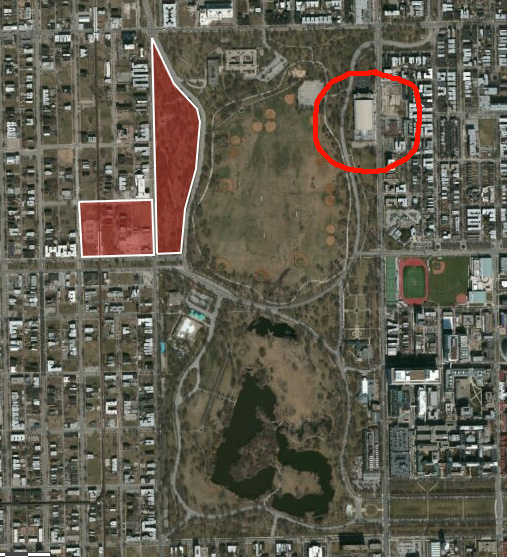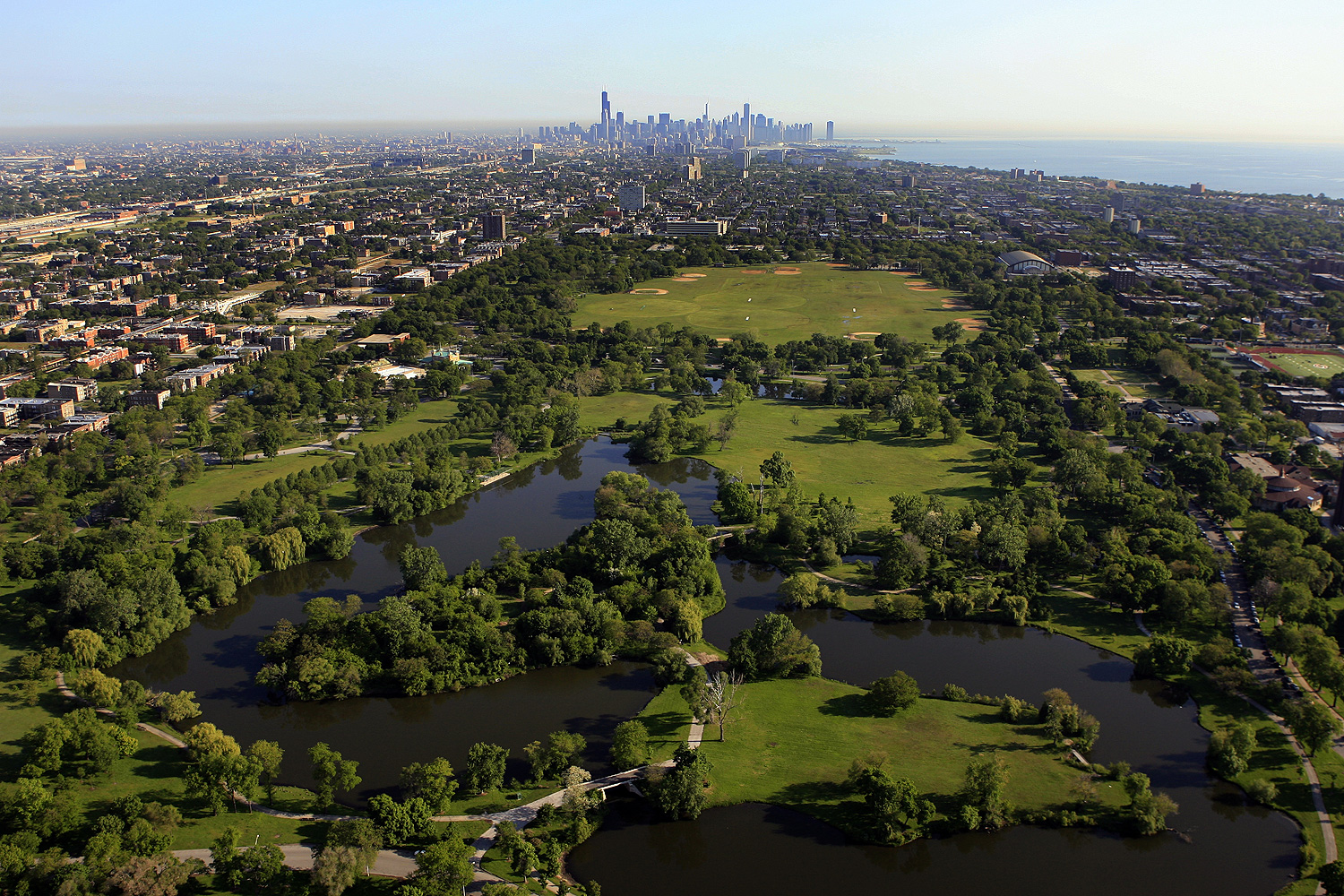The plan to put the Obama Presidential Library on park land is moving forward to what might be an inevitable conclusion, as Joe Cahill notes:
The Park District is supposed to be an independent agency devoted to the public's interest in a strong park system. As such, it has been entrusted with the legacy of Burnham, Olmsted and Jens Jensen in a historic, distinctive network of parks that few cities can match. Preserving, expanding and maximizing public benefit from Chicago's parks should be its top priority.
Lately, however, parks commissioners have put mayoral priorities ahead of the parks. They agreed to give lakefront land for George Lucas' Museum of Narrative Art, an Emanuel pet project.
(Cahill's argument that a trauma center would be a fair trade for the parkland is worth reading, as is Ben Joravsky's that the UIC plan should be favored.)
Since the legacy of the parks weighs so heavily on the decision, I was curious about what's been proposed to be built in Chicago's parks, which proposals made it through, and why. And generally speaking, the momentum of history seems favorable to the University of Chicago plan—museums have been looked upon more kindly as park amenities.
But park development has taken many forms; were it to end up in Washington Park, the Obama Library wouldn't be the first encroachment on the land, or the least defensible from a public-use perspective. And citizens' reaction has taken many forms as well. Sometimes building on parkland comes to a fight; sometimes it seems to have gone off without objection.
The most famous fight over museum-building on parkland in Chicago pitted two of the city's leading magnates against each other: Montgomery Ward and Marshall Field. Ward leveraged the famous description of the central city's lakefront as "Public Ground—Forever Open, Clear and Free of any Buildings, or Other Obstruction Whatsoever" to create "what may be the most illustrious park in the world," as Lois Wille writes in her definitive account of lakefront parkland, Forever Open, Clear and Free: The Struggle for Chicago's Lakefront.
Ward used that language to clean rubble and shanties of what's now Grant Park, and also fought off the mayor's plans for a civic center that would have placed a city hall, post office, police station, power plant, and stables in that area. Around the turn of the 20th century, Ward, through legal action, helped shoot down plans for armories (a plan favored by the Tribune, the better to station troops to put down labor riots and guard the ports).
All well and good—in retrospect, it's unlikely present-day Chicagoans would want a power plant on the city's front yard. The Field Museum, however, is one of the city's treasures. But Ward fought that, too.
At the turn of the century, Field's collection was housed in the old Palace of Fine Arts from the Columbian Exposition. For obvious reasons, Field and his directors wanted to move it to Grant Park. And they got some help, as Wille writes:
To make things easier for them—and to circumvent Ward—the state Legislature passed an act permitting cities and park districts to build museums in public parks and levy a tax to maintain the buildings.
Ward had previously chosen not to fight the Art Institute, though Wille suggests he would have objected to its later additions. And he agreed not to fight the Field Museum, as long as the park commission promised it would be the last building, which they obviously didn't agree to. So the fight wore on.
To make a long story—about a decade—short, Marshall Field's nephew, Stanley, brokered a deal to put the museum next to the park on reclaimed railroad land that wasn't part of the original "open, clear and free" designation. The Adler and the Shedd would join the Field in a museum center. "He was grateful, Stanley Field said years afterward, that Montgomery Ward had fought so hard to block the original site in Grant Park."
So that's the moral of the story, right? Actually, Wille and her book were dragged into a much later fight, one that would have the same conclusion, over the Children's Museum on Navy Pier and its plan to relocate to Grant Park. And the conclusion Wille came to might seem a surprise.
The Tribune's editorial board cited Wille in arguing against the move. Wille, formerly the editor of that same editorial page, didn't appreciate having her work used against the museum, as she told Michael Miner:
[I]n her view "clustering cultural entertainment" along East Randolph is OK "if they're low." And that if the museum is built the Gehry Bridge over Columbus Drive from Millennium Park will finally lead somewhere.
"They had a perfect right to quote my book — it's out there," said Wille, "but when you leave out the part about 'does it obstruct the view?' I think you're leaving out a really key element. You can also say that if what they quoted was followed today, that whole area would be meadowland, which might be pretty but it wouldn't attract tens of thousands of people from throughout the area."
Wille's book is a detailed account of the city's lakefront parks, and of the many dumb ideas to make it worse ("at one time Mayor Daley was enthusiastic about the proposal of a private company to build a 920-foot 'space needle' on top of [Navy Pier] with a revolving restaurant on top"). She goes so far as to suggest that Soldier Field should be torn down and replaced with more parkland.
And even Wille wasn't opposed to another museum in Grant Park. It echoes the city's mixed attitude towards park construction—sometimes a flashpoint, sometimes no big deal, depending on the use, or seemingly not depending on the use but just the fluctuations of time and opinion.
Take Washington Park, for instance, via the Trib.

On the left is the proposed presidential library site. On the right is the General Jones Armory, a 300,000 square-foot, $14 million (in 2014 dollars) structure built in Washington Park in 1931. Why Washington Park? "One of the advantages of the Washington park site, according to Col. Hammond, is the accessibility of the bridle paths," the Tribune reported in 1928. I don't see any indication that anyone actually cared at the time, though the Trib did later editorialize against the armory, the Chicago Historical Society building in Lincoln Park, and the rebuilding of the La Rabida sanitarium (now Children's Hospital) in Jackson Park. The last of those was protested, even though it arguably represented the least imposition on public grounds.
The armory and now-Chicago History Museum, obviously, went through. When the latter was expanded in the 1960s, the city plan commissioner said that "museums are not mentioned specifically in the commission's basic plan policies. He said, however, that the expansion of the facilities is in conformity with educational goals."
The armory site was actually a centerpiece for the city's Olympic bid, which would have relocated its National Guard functions—the Park District owns the land—and transformed it into an athletic facility. (It's also, ahem, presidential-library sized, some 50,000 square feet larger than the Ronald Reagan Presidential Library, the largest of all such institutions.)
A couple decades after the armory went up, Chicago Public Schools attempted to take another piece of Washington Park land, this time nine acres for the Dunbar Vocational and Trade School, just north of the armory site in the northeast corner of the park. One might think that a school would be a more popular use of parkland than an armory; one would be wrong. "Planners of the new school say that buildings actually will take only 3 per cent of the park space," Lovelyn J. Evans, the citizens' committee secretary, told the Tribune in March of 1949. "But even this is too much. Washington is one of the smaller major parks and is the only place that offers recreation and open space for residents in this congested area."
She was prescient. Wille writes that, by the 1960s, "Chicago had 3.16 acres of parkland recreation space for every 1,000 persons, the lowest ratio of any major city except for Washington, D.C…. The ratio of park-recreation space to population was nearly twice as high early in the century as it was in the 1960s." With the backing of residents, the parks board rejected the idea. Instead, the school, alma mater of Lou Rawls, Jennifer Hudson, and Mr. T, ended up at 30th and Martin Luther King, even though the city had to acquire private land to place it there.
There's not really a pattern over history; the city's willingness to build on its own parkland has varied with time, the interests of the public, and the interests of the most powerful members of that public. Several museums have gone up—but not the Children's Museum. Quasi-public edifices have been built, like McCormick Place and the General Jones Armory—but not the Dunbar School. Insofar as there's any pattern at all, the Obama and Lucas Museums seem to be on solid ground. Just don't go building anything for the kids.



